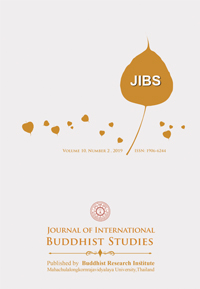Buddhist Wisdom Health Care Identities in the Cultural Geography of ASEAN Community
Keywords:
Buddhist wisdom health care, identities in the cultural geography, ASEAN communityAbstract
This research aims to study Buddhist wisdom that lines health care which becomes inter-identities of Thailand and other countries ASEAN Community. It was found that Buddhist wisdom health care is health care with a human mind, using the four noble truths and the four noble sentiments or the four of Brahma’s Dharma as the conceptual framework to understand the reality of life and to develop potential of a human being. The key elements in this health care are the ability to see humanity as the holistic, the ability to see the authentic suffering knowingly, and the ability to do qualified health care in the context of cultural geography. The ultimate goal is to help everyone concerned achieve complete happiness in life. Buddhist wisdom health care includes medical and local religious wisdom. These two kinds of wisdoms are interlinked and are the basis of cultural geography. They cover the philosophy of looking at the world, life goals, the philosophy of life, values and practice guidelines, the development of human life, health educational development, health technology, health policy, local wisdom, globalization, environment development, economic development, and social development.
References
Anne Ruth Hansen. (2008). How to Behave Buddhism and Mo- dernity in Colonial Cambodia 1860– 1930. Chiang Mai : Silkworm Books, p.111- 112.
Alexandra Kent. (2003). Recovery of the Collective Spirit: the Role of the Revival of Buddhism in Cambodia, p.8.
Christopher,S Queen. (1998) “The Peace Wheel: Nonviolent Activism in the Buddhist Tradition.” Subverting Hatred: The Challenge of Non- violence in Religious Traditions, Boston: Boston Research Center for the Twenty-First Century , p.6-7.
Damien, Keown. ( 2003). A Dictionary of Buddhism. New York: Oxford University Press, p.86.
Donald K. Swearer. (1986) “The Vision of Bhikkhu Buddhadasa,” in Bhikkhu Buddhadasa, Dhammic Socialism. Translated and edited by Donald K. Swearer. Bangkok: Thai Interreligious Commission For Development, p. 14.
George D. Bond. (1996) “A.T. Ariyatne and the Sarvodaya Shramadana Movement.” Engaged Budddhism: Buddhist Liberation Movements in Asia, Ed. By Christopher S. Queen. New York: State University of New York Press , p.126.
Heike Loschmann (2007). Buddhism and Social Development in Cambo- dia since the Overthrow of the Pol Pot Regime in 1979 in Siksacakr Journal (Special Issue on Buddhism). Center for Khmer Studies: Ponleu Khmer Printing &Publishing House, p.105.
Hirsch Rifka & Chea Sok Lim. (1986) The trauma of Cambodia: the psy- chological impact of mass violence. Refugee Studies Centre : Boston. Massachusetts, p. 1- 6 Available at < http://repository .forcedmigra- tion. org/show_ metadata.jsp? pid=fmo:299,(27 Jan. 2010, 5:44 PM.)
Ian Harris.(1999). Buddhism in Extremis the Case of Cambodia :Buddhismand Politics in Twentieth - Century Asia. Cromwell Press.Ltd., 64. ________. (2006). Cambodian Buddhism: History and Practice. Chiang
Mai : Silkworm Books, , p.195.
________. (2007). Buddhism under Pol Pot. Phnom Penh : Documentation
Center of Cambodia, p.179.
Keyes Charl F. (1994) Communist Revolution and the Buddhist Past in
Cambodia’ in Keyes, Charles F. Laural Kendall and Helen Hardare (eds) Asian Vision of Authority: Religion and theModern State of East and Southeast Asia. Honolulu :University of Hawaii Press, p.53
Koslyn Reedy. (2007). The mental Health Conditions of Cambodian Refu- gee Children and Adolescents, M.A of Research distinction in Inter- national studies , Ohio state Un. (Unpublished), p.9.
Leakkhena Nou. (2006) A QualitativeExamination of the Psychosocial Adjustment of Khmer Refugee in Three Massachusetts Community. Massachusetts Boston: Institute of Asia American Studies, p. 1 - 5.
Margaret Slocomb. (2003). The People’s Republic of Kampuchea 1979 -1989 The Revolution after Pol Pot. Chiang Mai : Silkworm Book , p.180.
Puntarigvivat, Tavivat.(1992) “Luangpor Teean : The Dynamic Practices of a Thai Meditation Master,” in Grant A. Olson (editor), Crossroads, Volume 7, Number 1 (DeKalb : Northern Illinois University, p. 69 - 89.
Royal Academy. (2003).Universal Dictionary of Religion Academy of Letters. Type the two amendments. Bangkok: Arun printing, p. 65-66. Samsopheap Preap. (2005). “A Comparative study of Thailand and Khmer
Buddhism” International Master Degree of Arts Program Gratitude School .Buddhist Studies. Bangkok: Mahachulalongkornrajavidya- laya University.
Suzannal Linton. (2004).Reconciliation in Cambodia. Phnom Penh: Docu- mentation Center of Cambodia , p. 12, 75 - 77.
The Dalai Lama. (1996) “Cultivating Altruism,” Engaged Buddhist Leader, ed. By Kotler, Arnold (Berkeley : Parallax Press, p 3.
Thich Nhat Hanh. (1991) . Peace Is Every Step. New York: Bantam, p. 91. Yim Sombo and Others. (2007). The Threads of Continuity: Buddhism and Conflict in Cambodia, 1953 to 1979. in Siksacakr, Penny Edwards, Michel Rethy Antelme, Editors, Center for Khmer Studies: Ponleu
Khmer Printing& Publishing House, p.86.
Yos Hut Khemacaro. (1998)Steering the Middle path: Buddhism, non-vi-
olence and political change in Cambodia in An international Review of Peace Initiative. Accord Safeguarding Peace: Cambodia’s consti- tutional challenge, London : Conciliation Resource , p.71 -75.







